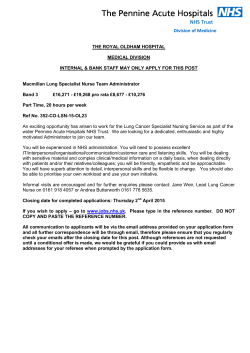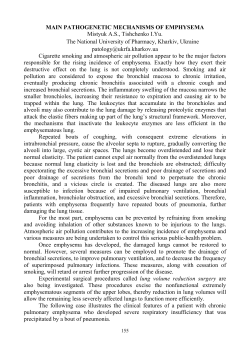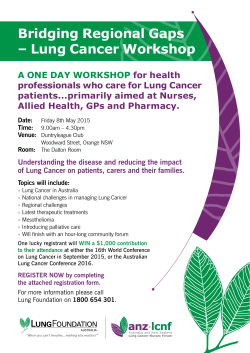
Lung Capacity - Myschoolpages.com
Name: _____________________ Lung Capacity BACKGROUND: An individual’s breathing rate is influenced by many factors. The position of the body, general physical condition, strength of the diaphragm and chest muscles, and disease all affect the ability of the lungs and the chest cavity to work efficiently during respiration. Such diseases as the common cold, emphysema, asthma, bronchitis, cancer and tuberculosis reduce the efficiency of the respiratory system. In this lab you will be using a technique which roughly estimates your vital lung capacity. This is the maximum amount of air that you can inhale and then exhale into a balloon. The average volume for female lungs is about 3400-3500ml. The average male lung capacity is about 4400-4500ml. Athletes may have 30%-40% greater lung capacity. MATERIALS: - Balloon - Graph paper - String - Meter stick PROCEDURE: 1. Prepare the balloon – stretch and fill the balloon with air a few times. 2. Working with a partner, take a few deep breaths and exhale deeply once into the balloon. Fill the balloon as much as you can, but only with air from one exhalation. 3. Pinch off the end of the balloon; but do not tie it off. 4. Have your partner measure the circumference of the balloon at its widest point using the string. 5. Hold the measured string along the meter stick to determine the circumference of the balloon in cm. 146 6. Record the circumference of the balloon on the data table. 7. Repeat steps 2-6 two more times and then determine your average lung capacity using the formulas below. When done, switch roles with your partner. 8. Add your data to the class data and then graph the class data. FORMULAS: C = 2πr V = 4/3πr3 DATA TABLE TRIAL CIRCUMFRENCE (cm) RADIUS (cm) 1 2 3 Average lung capacity in ml ____________________ 147 CAPACITY (ml) CLASS DATA FEMALES MALES 148 DISCUSSION QUESTIONs: Using complete sentences answer the following questions on a separate sheet of paper. 1. Compare the class results to your results. Explain where you fit in and offer an explanation as to why you fit in where you do. 2. Explain how the data might be used to predict the heavy smokers or asthma sufferers in class. 3. What might have interfered with the collection of data in this lab? 4. Why might males have a greater lung capacity than females? 5. Why might athletes have a greater lung capacity than non-athletes? 6. How can lung capacity be increased? 7. Explain what emphysema is, how a person develops it and what can be done to cure it. INTERPRETATION QUESTION: Write a story in the 1st person to answer the following scenario: Pretend you are a molecule of oxygen. Explain the path that you would take if you were inhaled, used in the process of cellular respiration and then exhaled as a different molecule. Be sure to include ALL the places you travel through on the way in and on the way out as well as what happen in those places. The trip through the human respiratory system is longer than you think! 149 Alveoli Activity To accompany the lung capacity lab 1. Draw a picture of alveoli. In the drawing be sure to label: - the gasses diffusing through the wall of the alveoli in which direction the gasses are traveling the blood vessels that surround the alveoli 2. Answer the following questions on the same page as your drawing in complete sentences. - List several characteristics of alveoli - What type of blood vessels surround alveoli - Why are alveoli important (be as specific as possible) 150
© Copyright 2024
















